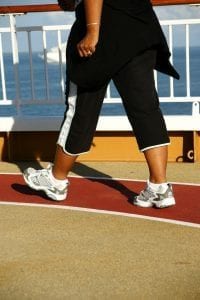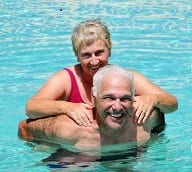
Exercise Throughout the Ages
Posted by cbrooks on Apr 23, 2019 in Health Blog | Comments Off on Exercise Throughout the AgesLearn how to stay fit and healthy at any age.
Exercise is essential to maintaining the health of the mind and body, but it’s not a “one size fits all” activity. Younger bodies can be pushed in ways older bodies cannot, but that doesn’t mean one should give up on staying fit as one ages. In fact, it becomes all the more necessary the older you get. What are the best ways to exercise through the decades?
Let’s break it down:
In your teens and twenties: It’s all about the cardio. 
This is the ideal age bracket to take up jogging, or another high-intensity cardiovascular workout. This will build stamina, strengthen the heart and lungs, and keep the metabolism at its peak. In the same way many start to save up for their first car and home during their younger years, one should also take advantage of the fact that young joints can more easily bear the load of weights, and young bodies can more easily build muscle. Hit the gym and build as much muscle as you can; simply carrying around muscle burns up to five times more calories than carrying around fat, something that will help keep you lean and healthy as you get older.
From your thirties to your fifties: 
a. Slow it down a notch
As joints begin to experience wear and tear, high-impact cardio like jogging may no longer be the best solution, possibly causing pain and tiredness that will wind up discouraging one from exercising. Instead, switch to lower-impact exercise like walking. Walking has been proven to provide much of the same health benefits as higher-impact cardio. For weight loss, try to walk 10,000 steps per day. Use a pedometer to count your steps.
b. Learn how to swim.
If you don’t already know how, this is also a great time to learn how to swim, as swimming keeps the whole body fit and burns a lot of calories without putting a lot of pressure on the joints. If you find yourself a victim of middle-aged weight gain, this is also a comfortable way for heavier people to get back into shape.
c. Exercise on the go.
This age group tends to be very busy, so it’s advised to work as much “N.E.A.T.” into your day as possible. N.E.A.T. is an acronym that stands for non-exercise activity thermogenesis. It’s a way to burn more calories by doing everyday activities. For instance, take the stairs at work, lift weights while waiting for a call, walk about when taking a call on a cordless or a cell phone. Make it a habit. When the phone rings, answer it then automatically stand up; stretch, often at work, when watching TV; take the bus instead of driving; get a stress ball and squeeze it often—all these little things can add up to burn hundreds of calories a day, without spending any (additional) time at the gym.
d. Maintain.
Try to fit in some resistance training at least a few times a week, to keep the muscles you developed in your twenties in good condition, and to help retain bone density.
Fifty-plus.
Swimming and other forms of aqua-fitness are arguably the best mode of exercise for older adults. Swimming involves both aerobic activity and working against resistance, all while being gentle on the joints and helping to support up to 90% of a person’s weight.
Arthritis sufferers also benefit from swimming; studies have shown that it improves a patient’s range of motion without worsening pain or stiffness. Also, it has been shown in studies to reduce your risk of osteoarthritis.
b. Stay active in your day-to-day life.
It’s important not to sit around too much, but some older people don’t have the energy to walk for miles or do intense cardio. Instead, work short trips into your day, such as walking to the store, or walking around your neighborhood. Rather than watching television, go out and garden. Choose fun, active hobbies and stay social in order to keep consistent light exercise a part of your day-to-day life. This age group can also benefit from getting more N.E.A.T. Don’t give up on weights or exercise bands. Doing light resistance training with supervision is a great way to prevent the loss of bone density, and it’s essential to preventing the loss of muscle structure and function as you age. If you want to stay fit and healthy throughout the ages, make exercise a part of your daily routine.
If you need help developing a movement plan, please contact me. I will work with you to develop a moving program that is ” just right” for you!
Sign-up for my “FREE” Assured Wellness Newsletter and receive valuable healthy tips and tools you can use.
Thank you for visiting! Please come again!
Your partner in health and wellness,
Coach Cindy


